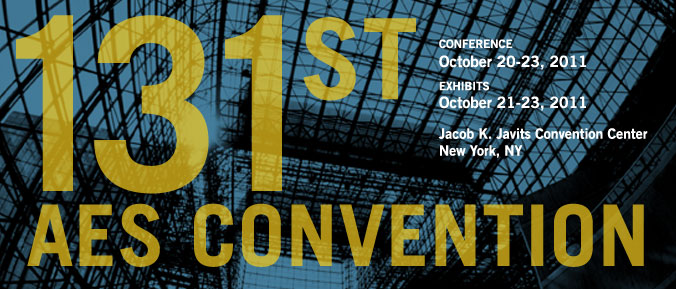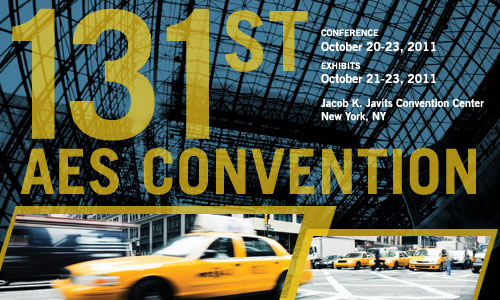
AES New York 2011
Poster Session P14
P14 - Audio Processing
Friday, October 21, 2:30 pm — 4:00 pm (Room: 1E Foyer)
P14-1 Acoustic Channel Decorrelation with Phase Modification for Stereo Acoustic Echo Cancellation—Jae-Hoon Jeong, So-Young Jeong, Woo-Jeong Lee, Jung-Eun Park, Jeong-Su Kim, Yongje Kim, Samsung Electronics Co., Ltd. - Suwon, Korea
In this paper we propose a novel acoustic channel decorrelation method, which prevents poor convergence in stereophonic echo cancellation. In order to minimize audio quality degradation while maximizing channel decorrelation, the proposed method provides a subband phase modification of each channel, which depends on the amount of inter-channel phase difference so that redundant phase alteration is avoided. In addition, we introduce a phase control parameter for each subband to preserve perceptual stereo image of each channel. The performances of the proposed method are verified with MUSHRA subjective audio quality test, impulse response misalignment, and echo return loss enhancement. The results show that the proposed method has a good decorrelation performance while minimizing signal distortion and stereo image change.
Convention Paper 8519 (Purchase now)
P14-2 Least-Squares Local Tuning Frequency Estimation for Choir Music—Volker Gnann, Markus Kitza, Julian Becker, Martin Spiertz, RWTH Aachen University - Aachen, Germany
Choir conductors often have to deal with the problem that the tuning pitch of a choir tends to decrease gradually over time. For that reason, we present an algorithm that measures and displays the tuning frequency evolution for polyphonic choir music over time. Basically, it analyzes the short-time Fourier spectrogram, picks out the most important peaks, and determines their frequencies. From these frequencies, the algorithm calculates the concert A pitch that leads to the smallest least-squares-error when the measured frequencies are sorted into a semitone grid.
Convention Paper 8520 (Purchase now)
P14-3 A Low Latency Implementation of a Non Uniform Partitioned Overlap and Save Algorithm for Real Time Applications—Andrea Primavera, Stefania Cecchi, Laura Romoli, Paolo Peretti, Francesco Piazza, Universita Politecnica delle Marche - Ancona, Italy
FIR convolution is a widely used operation in the digital signal processing field, especially for filtering operations in real time scenarios. In this context low computationally demanding techniques for calculating convolutions with low input/output latency become essential, considering that the real time requirements are strictly related to the impulse response length. In this paper a multithreaded real time implementation of a Non Uniform Partitioned Overlap and Save algorithm is proposed with the aim of lowering the workload required in applications like reverberation, also exploiting the human ear sensitivity. Several results are reported in order to show the effectiveness of the proposed approach in terms of computational cost, taking into consideration different impulse responses and also introducing comparisons with existing techniques of the state of the art.
Convention Paper 8521 (Purchase now)
P14-4 3-D Audio Depth Rendering Method for 3-DTV—Sunmin Kim, Young Woo Lee, Yongje Kim, Samsung Electronics Co., Ltd. - Suwon, Korea
This paper proposes a novel 3-D audio depth rendering method with stereo loudspeakers in order to enhance an immersion of 3-D video contents. The 3-D audio depth rendering system for 3-DTV consists of an audio depth index that estimates the distance of an audio object between TV and a listener, and a distance control algorithm based on the audio depth index. Two kinds of audio depth index estimation algorithms are presented. One utilizes a disparity map of stereo image, and the other tracks loudness of stereo audio signal. Listening tests show that the proposed audio depth rendering system allows the listener to feel the depth of the sound corresponding to a pop-up effect of the 3-D image.
Convention Paper 8522 (Purchase now)
P14-5 Virtual Height Speaker Rendering for Samsung 10.2-Channel Vertical Surround System—Young Woo Lee, Sunmin Kim, Samsung Electronics Co., Ltd. - Suwon, Korea; Hyun Jo, Youngjin Park, KAIST - Daejeon, Korea; Yongje Kim, Samsung Electronics Co., Ltd. - Suwon, Korea
This paper proposes the virtual sound elevation rendering algorithm that can give a listener an impression of virtual 10.2 channel loudspeakers. The proposed algorithm requires 10.2 channel input signals and the conventional 7.1 channel loudspeaker system (ITU-R BS.775-2). The proposed virtual height speaker rendering consists of generic head-related transfer function (HRTF), which is calculated using 45 individualized HRTFs of CIPIC datasets, and a mixing algorithm using four loudspeakers among 7.1 channels. For subject evaluation, three kinds of playbacks are compared with various materials: original 10.2 channel signal, down-mixed 7.1 channel signal, and the proposed 7.1 channel signal in terms of source positioning, envelopment, and overall sound quality.
Convention Paper 8523 (Purchase now)
P14-6 Non Linear Convolution and its Application to Audio Effects—Lamberto Tronchin, University of Bologna - Bologna, Italy
The non linear convolution could be applied to enhance the linear convolution on acoustic musical instruments and audio devices. In this paper a novel technology, based on exponential sine sweeps measurements, is presented. The non linear convolution is based on the Volterra series approach and enables real time non linear emulation of acoustic devices (as valve amplifiers and musical instruments). The new developed tool (a VST plugin developed in C++ in JUCE framework) will be presented. The emulation of musical instruments will be compared with real recordings. The results will be finally analyzed and commented.
Convention Paper 8524 (Purchase now)
Information Last Updated: 20111005, mei

